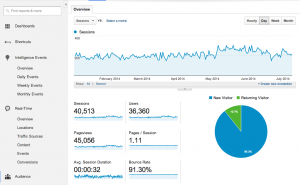We have had a lot of success in getting our client’s blog posts to
But make no mistake about it, getting page one

While this article discusses the steps to create and implement an effective content calendar, and we highly recommend you read about all of them, here is a quick list of our recommendations:
- Create a list of topics that are interesting to your audience
- Determine your resources and choose a publishing schedule that you can stick to
- Research the best Keyword or Keyword phrase to target for each article
- Tailor the length of your blogs to their intended audience
- Include a schedule to promote your articles on your social media channels
It all starts with a well thought out content calendar. Here are some of the strategies that we employ that have driven great results.
Create an effective content calendar – Tip #1 – Create a list of topics that are interesting to your audience
Create an interesting list of topics and put them in a content calendar. Plan to publish at least two blogs per month if possible. The more you publish, the more you will look like an authority in your space – and Google will notice!
Take time on this list – it’s really important! Ask all members of your team for their Top 10 topics and use these as a guide to narrow down your list. Remember, you are going to need a lot of topics if you are planning on publishing 24 or more blogs per year.
Revisit your list as things change. Move topics up in the calendar if they become trendy. Remember, you want to be early to the party in order to grab a top spot in the SERPs!
Create an effective content calendar – Tip #2 – Determine your resources and choose a publishing schedule that you can stick to
Your primary goal should be to produce good content on a regular basis. This will help to improve your site authority in Google’s eyes.
How often depends on your available resources – both in terms of people and time. Identify the authors you have and tailor your publishing schedule with those resources in mind.
We often see clients bite off more than they can chew, and if you choose a schedule that is too aggressive, you may find that nothing gets done. In short, d
If you don’t have writers in-house, spend some money to have your articles professionally written. There are many bloggers for hire out there that produce great work at a reasonable price.
One great outsourcing resource we have used is called Upwork, an online portal where you can find talented freelancers. Just post a detailed job request and you will often get multiple responses from interested writers willing to take on your project! Another great outsourcing service is
Create an effective content calendar – Tip #3 – Research the best Keyword or Long-tail Keyword phrase to target for each article
For each topic, do a Google search using the keyword or phrase you think people will use to find your article. If the keyword is a popular one and the results on page one are all highly authoritative sites, it will be hard to overtake them.
To use an example, let’s say you are a financial planner and you are writing an article about “smart investment strategies”. If you do a Google search for that phrase, the results that come up on page 1 are from Vanguard, Forbes, USNews, CNBC and Merrill Lynch. That will be a hard mountain to climb!
A better strategy would be to research a different keyword phrase and tailor your article around that phrase. Try to think of similar alternatives, do a Google search on them and look for results that you think you have a chance of outranking.
Perhaps something like “investment strategies that work”. You have to do some research to find the right term that you want to win.
Creating and Implementing an effective content calendar – Tip #4 – Make sure to match the length of each blog to the particular target audience
We find that the minimum length of your articles should be 800 words. But, this will vary depending on the intended audience of each blog. For example, if one topic is intended to answer a specific question that a consumer might find useful, that should probably be a shorter piece (400 words or so).
Another article might be targeted at people trying to learn about a topic or service you provide. They will probably be willing to invest their time reading a longer piece.
The goal is to get the reader to take the time to read the whole article (and hopefully share it!).
Here’s a good article that discusses How Long Should Your Blog Post Be?
Tip #5 – Include a schedule to promote your articles on your social media channels
Once you have created a good piece of content, you need to share it with the world! Post it immediately on all of your social media pages and plan to post it again on a periodic basis.
Make sure to add this to your calendar so you have a systematic approach to sharing your content.
You should also consider increasing your audience by promoting or “boosting” your posts through paid ads. This is really easy to do on Facebook, Twitter, LinkedIn, and other social sharing sites and could be well worth the cost while you are building your brand and audience.
Creating an Effective Content Calendar Doesn’t Mean You Should Ignore Your Old Stuff!
In our experience, fresh content is a must, but you should also pay attention to older, “evergreen” content on your blog. Make sure you pay attention to articles that are getting eyeballs already! Check Google Analytics to see which blogs are producing page views every month.
Keep these articles fresh by periodically adding new, relevant information about the topic. If necessary, rewrite the article to bring it current. Use new quotes and add new outbound links to other authoritative websites to bolster your article.



